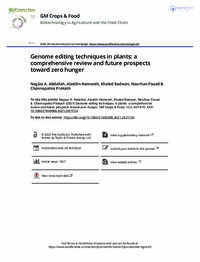Genome editing techniques in plants: a comprehensive review and future prospects toward zero hunger

Authors:
Promoting sustainable agriculture and improving nutrition are the main United Nation’s sustainable
development goals by 2030. New technologies are required to achieve zero hunger, and genome
editing technology is the most promising one. In the last decade, genome editing (GE) using the
CRISPR/Cas system has attracted researchers as a safer and easy tool for genome editing in several
living organisms. GE has revolutionized the field of agriculture by improving biotic and abiotic
stresses and yield improvement. GE technologies were developed fast lately to avoid the obstacles
that face GM crops. GE technology, depending on site directed nuclease (SDN), is divided into three
categories according to the modification methods. Developing transgenic-free edited plants without
introducing foreign DNA meet the acceptance and regulatory ratification of several countries.
There are several ongoing efforts from different countries that are rapidly expanding to adopt the
current technological innovations. This review summarizes the different GE technologies and their
application as a way to help in ending hunger.
